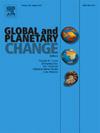在中国干旱和半干旱地区,蒸散量的增加对植被绿化比对植被类型转换更敏感
IF 4
1区 地球科学
Q1 GEOGRAPHY, PHYSICAL
引用次数: 0
摘要
蒸散发(ET)是水循环和能量平衡的重要组成部分,而植被是影响蒸散发的关键因素。植被主要通过两种模式影响蒸散发:植被生长变化(VGC)和植被类型转换(VTC)。尽管植被生长变化和植被类型转换对蒸散发的影响机制不同,但以往的研究很少区分它们各自的影响。这使得 VGC 和 VTC 对蒸散发变化的相对贡献不明确。为了填补这一空白,本研究将重点放在中国的干旱和半干旱地区(ASAC)。利用 2001 年至 2018 年的遥感蒸散发数据分析了中国干旱半干旱地区的蒸散发时空格局。结合叶面积指数(LAI)和土地利用/土地覆盖(LULC)数据进行配对比较和贡献分析,研究了VGC和VTC对蒸散发的具体影响。结果表明,整个亚洲-中亚地区的年平均蒸散发量有明显增加,增幅为 4.5 毫米/年(p < 0.05)。与草地相比,林地和耕地的增加更为明显。蒸散发在所有季节都有增加,夏季增加最多,约占全年蒸散发增加量的 50%。成对比较和贡献分析表明,非洲撒哈拉以南地区的蒸散发对植被绿化的敏感性高于对风调雨顺的敏感性。在不同的 LULC 变化类型中,VTC 对蒸散发量的变化起着调节作用,相对贡献率从 1.3% 到 57.8% 不等。这些发现加深了我们对植被变化如何影响蒸散发的理解。这些研究结果还能为亚洲和太平洋地区的土地管理策略提供有价值的见解,从而优化植被建设,促进生态系统的可持续发展。本文章由计算机程序翻译,如有差异,请以英文原文为准。
Evapotranspiration increase is more sensitive to vegetation greening than to vegetation type conversion in arid and semi-arid regions of China
Evapotranspiration (ET) is a crucial component of both the water cycle and energy balance, with vegetation being a key factor influencing ET. Vegetation impacts ET primarily through two modes: vegetation growth change (VGC) and vegetation type conversion (VTC). Despite the different mechanisms by which VGC and VTC influence ET, previous studies have rarely differentiated their individual effects. This has left the relative contributions of VGC and VTC to ET changes unclear. To address this gap, this study focuses on the arid and semi-arid regions of China (ASAC), where substantial vegetation changes have been observed. The spatiotemporal patterns of ET in ASAC were analyzed using remote sensing ET data from 2001 to 2018. The leaf area index (LAI) and land use/land cover (LULC) data were incorporated to perform pairwise comparison and contribution analysis to investigate the specific effects of VGC and VTC on ET. The results revealed a significant increase in mean annual ET across ASAC, with a rate of 4.5 mm/yr (p < 0.05). This increase was more pronounced in forest land and cropland compared to grasslands. ET increased across all seasons, with the largest increase occurring in summer, accounting for approximately 50 % of the annual ET increment. The pairwise comparison and contribution analysis indicated that ET in ASAC is more sensitive to vegetation greening than to VTC. VTC played a moderating role in ET changes, with relative contribution ranging from 1.3 % to 57.8 % across different LULC change types. These findings enhance our understanding of how vegetation changes influence ET. They can also provide valuable insights for land management strategies in ASAC, aiming to optimize vegetation construction and promote ecosystems sustainability.
求助全文
通过发布文献求助,成功后即可免费获取论文全文。
去求助
来源期刊

Global and Planetary Change
地学天文-地球科学综合
CiteScore
7.40
自引率
10.30%
发文量
226
审稿时长
63 days
期刊介绍:
The objective of the journal Global and Planetary Change is to provide a multi-disciplinary overview of the processes taking place in the Earth System and involved in planetary change over time. The journal focuses on records of the past and current state of the earth system, and future scenarios , and their link to global environmental change. Regional or process-oriented studies are welcome if they discuss global implications. Topics include, but are not limited to, changes in the dynamics and composition of the atmosphere, oceans and cryosphere, as well as climate change, sea level variation, observations/modelling of Earth processes from deep to (near-)surface and their coupling, global ecology, biogeography and the resilience/thresholds in ecosystems.
Key criteria for the consideration of manuscripts are (a) the relevance for the global scientific community and/or (b) the wider implications for global scale problems, preferably combined with (c) having a significance beyond a single discipline. A clear focus on key processes associated with planetary scale change is strongly encouraged.
Manuscripts can be submitted as either research contributions or as a review article. Every effort should be made towards the presentation of research outcomes in an understandable way for a broad readership.
 求助内容:
求助内容: 应助结果提醒方式:
应助结果提醒方式:


